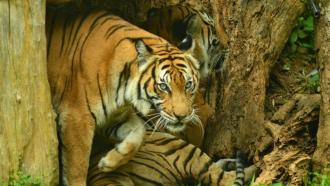Photo : Artecology Initiative
Because this is a monsoon poem
expect to find the words jasmine
palmyra, Kuruntokai, red; mangoes
in reference to trees; paddy
fields, peacocks, Kurinji flowers,
flutes; lotus buds guarding love’s
furtive routes
wrote poet Tishani Doshi, an Indian poet, journalist and dancer, to describe the various facets of monsoon. For each of us, monsoon is a sensory treat, and for all of us, it is crucial for the sustenance of agriculture, river systems and a plethora of flora and fauna. Recent spells of monsoon rains have dispelled these romantic feeling about the rains; there is more misery instead. And we have none to blame except our own misunderstanding, and consequent mismanagement of our environment.
Understanding the myriad concepts of our natural environment, our interaction with its elements and its consequences are of paramount importance for our own living. In order to facilitate such an understanding, a group of science communication enthusiasts will be showcasing a movement-based performance titled, “How to be a Fig” on 23rd September, 6 pm at the J. N Tata Auditorium, as part of the Student Conference on Conservation Science – Bengaluru.
“How to be a Fig?” is a collaborative project between scientists and artists. Inspired by Mike Shanahan’s book on Figs titled “Ladders to Heaven”, this movement piece aims to unravel the mystery of these magnificent trees. The artists are attempting to express the complex role that Fig trees play in the ecosystem through the human body. This project has brought together people from diverse backgrounds with a common thread that connects them all – their love for trees.
Figs, known as keystone species, support the lives of a wide range of organisms. With a multitude of purposes that it serves, the collaborators decided to shine the spotlight on key themes. “The secret garden inside a fig, the fig wasp nursery, predation of fig wasps, strangler figs and the lives of animals dependent on figs are some of the themes that we will be touching upon during the performance”, mentions Abhisheka Krishnagopal, an artist and naturalist from the Artecology Initiative, who has conceptualized the piece.
Well if you thought dance is for the artists, think again! An interesting part of this performance is the participation of researchers -- people from non-dancing background -- who are enthusiastic about communicating science. “Specialization in their respective fields could easily disconnect the scientists from the public and render their science inaccessible to the general public. Through this collaboration, we wanted to provide imaginative ways for ecologists, biologists and other scientists to be able to express their discoveries in artistic ways”, say Veena Basavarajaiah, a contemporary movement artist who choreographed the performance.
So how did these scientists feel being a part of an artistic performance? “For me, the most interesting part of this whole experience was that we had to think about an ecological interaction or behaviour and then to express that through our movement. And thanks to such an endeavor, we all took part in this thinking process”, says Kasturi Saha, a research scholar at the Centre for Ecological Sciences.
Veena’s association with Abhisheka subsequently led to the How to be a Fig, which has a now teamed up with researchers from the Indian Institute of Science, Bengaluru - Ipsa Jain and Vignesh Venkateswaran -- and is delivering this unique performance. “The project is not limited to activism, but is an attempt to bring about awareness and reconnect the audience to the natural world. Through this initiative, we hope to bring in diverse people from different walks of life to understand that humans are an inextricable link to the natural world, and that conservation is the duty that every human being shoulders”, the team adds.
The performance will be presented as a part of the Student Conference on Conservation Science – Bengaluru, happening from the 21st -24th of September, 2017. It is open for all -- scientists or otherwise. “I hope that people who see the performance will be inspired to learn more about the fig trees and the symbiotic relationship they share with their wasps. This story has important links to our own. It reminds us that we are part of a wider ecological reality, and presents us with opportunities to rethink our relationship with nature, as well as find paths to a more secure future”, states Mr. Shanahan, author of Ladders to Heaven, a book that opens up the world of figs in a poetic manner. “It is a powerful way to communicate not only the beauty and elegance of nature, but also important lessons about interdependence and resilience”, he adds.
So, if you are curious about how to be a fig, rush to the Indian Institute of Science before the seats fill up!






